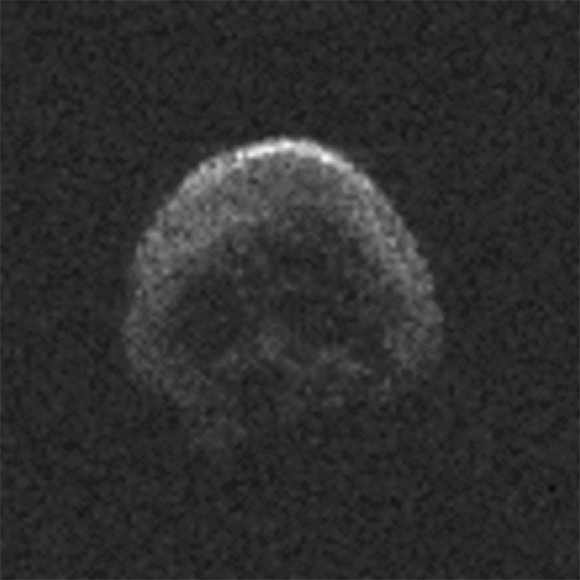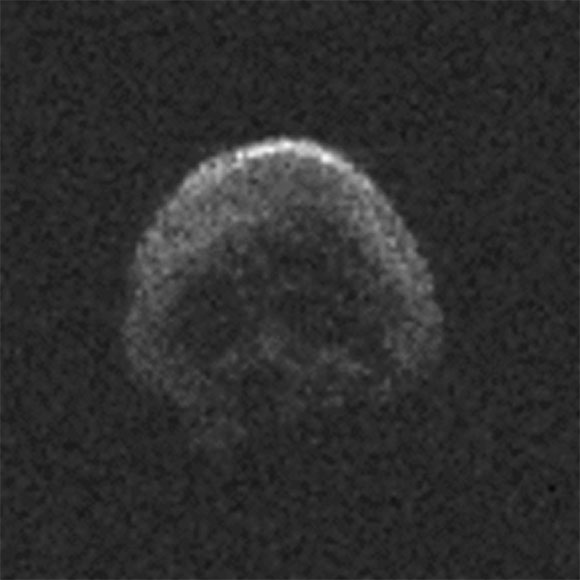
Just in time for Halloween, a large space rock that bears an eerie resemblance to a skull will zip past Earth this weekend.
Scientists observing asteroid 2015 TB145 with NASA’s Infrared Telescope Facility (IRTF) on Mauna Kea, Hawaii, have determined that the celestial object is more than likely a dead comet that has shed its volatiles after numerous passes around the sun.
The belated comet has also been observed by optical and radar observatories around the world, providing even more data, including our first close-up views of its surface. Asteroid 2015 TB145 will safely fly by our planet at just under 1.3 lunar distances, or about 302,000 miles (486,000 kilometers), on Halloween (October 31) at 1 p.m. EDT (10 a.m. PDT, 17:00 UTC).
The first radar images of the dead comet were generated by the National Science Foundation’s 305-meter (1,000-foot) Arecibo Observatory in Puerto Rico. The radar images from Arecibo indicate the object is spherical in shape and approximately 2,000 feet (600 meters) in diameter and completes a rotation about once every five hours.
“The IRTF data may indicate that the object might be a dead comet, but in the Arecibo images it appears to have donned a skull costume for its Halloween flyby,” said Kelly Fast, IRTF program scientist at NASA Headquarters and acting program manager for NASA’s NEO Observations Program.
Managed by the University of Hawaii for NASA, the IRTF’s 3-meter (10-foot) telescope collected infrared data on the object. The data may finally put to rest the debate over whether the 2015 TB145, with its unusual orbit, is an asteroid or is of cometary origin.

“We found that the object reflects about six percent of the light it receives from the sun,” said Vishnu Reddy, a research scientist at the Planetary Science Institute, Tucson, Arizona. “That is similar to fresh asphalt, and while here on Earth we think that is pretty dark, it is brighter than a typical comet which reflects only 3 to 5 percent of the light. That suggests it could be cometary in origin –- but as there is no coma evident, the conclusion is it is a dead comet.”
Asteroid 2015 TB145 was discovered on October 10, 2015, by the University of Hawaii’s Pan-STARRS-1 (Panoramic Survey Telescope and Rapid Response System) on Haleakala, Maui, part of the NASA-funded Near-Earth Object Observations (NEOO) Program. The next time the asteroid will be in Earth’s neighborhood will be in September 2018, when it will make a distant pass at about 24 million miles (38 million kilometers), or about a quarter the distance between Earth and the sun.
Radar is a powerful technique for studying an asteroid’s size, shape, rotation, surface features, and surface roughness, and for improving the calculation of asteroid orbits. Radar measurements of asteroid distances and velocities often enable the computation of asteroid orbits much further into the future than would be possible otherwise.
NASA places a high priority on tracking asteroids and protecting our home planet from them. In fact, the U.S. has the most robust and productive survey and detection program for discovering near-Earth objects (NEOs). To date, U.S.-funded assets have discovered over 98 percent of the known NEOs.
In addition to the resources NASA puts into understanding asteroids, it also partners with other U.S. government agencies, university-based astronomers, and space science institutes across the country, often with grants, interagency transfers, and other contracts from NASA, and also with international space agencies and institutions that are working to track and better understand these objects. In addition, NASA values the work of numerous highly skilled amateur astronomers, whose accurate observational data helps improve asteroid orbits after they are found.
NASA’s Jet Propulsion Laboratory, Pasadena, California, hosts the Center for Near-Earth Object Studies for NASA’s Near-Earth Object Observations Program within the agency’s Science Mission Directorate.
Never miss a breakthrough: Join the SciTechDaily newsletter.